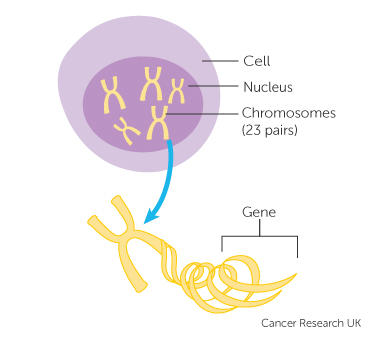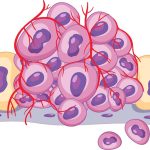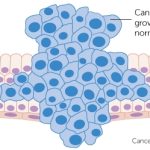DNA and genes
Inside almost every cell in your body is a structure called the nucleus. This is the control centre of the cell. Inside the nucleus are 23 pairs of chromosomes. These are long strings of DNA.

DNA stands for deoxyribonucleic acid (pronounced dee-oxy-rye-bow-nu-clay-ik acid). Each string of DNA looks like a twisted ladder. Scientists call this a double helix.

You have more than 2 metres of DNA inside every cell. But is very tightly coiled up so it all fits. DNA is like a code containing all the instructions that tell a cell what to do. It is made up of genes. Humans have around 25,000 genes in total.
You inherit half your DNA from your mother and half from your father. So you have 2 copies of every gene.
Your genes carry all the information that makes you, you. For example they tell your body to have blonde hair, or brown skin, or green eyes. And they tell your cells:
- what sort of cell to be
- how to behave
- when to grow and reproduce
- when to die
Some genes control how much each cell grows and divides.
How faulty genes lead to cancer
Our genes pick up mistakes that happen when cells divide. These mistakes (or faults) are called mutations. Mutations can happen throughout our lives, during natural processes in our cells. Or they can happen because of other factors such as:
- tobacco smoke
- high energy (ionising) radiation, such as x-rays
- ultraviolet radiation from the sun
- some substances in food
- chemicals in our environment
Sometimes people inherit certain faulty genes from their parents. This can mean that they have an increase in their risk of cancer.
It is usual for cells to repair faults in their genes. When the damage is very bad the cell may self destruct instead. Or the immune system  may recognise them as abnormal and kill them. This helps to protect us from cancer.
may recognise them as abnormal and kill them. This helps to protect us from cancer.
Sometimes mutations in important genes cause a cell to no longer understand instructions. The cell can start to multiply out of control. It doesn’t repair itself properly, and it doesn’t die when it should. This can lead to cancer.
There are 4 main types of genes involved in cell division. Most tumours have faulty copies of more than 1 of these types. You can read more about the 4 types below.
Genes that encourage the cell to multiply (oncogenes)
Oncogenes are genes that, under normal circumstances, tell cells to multiply and divide. In adults this doesn’t happen very often.
We can think of oncogenes as being a bit like the accelerator pedal in a car. When they become active they speed up a cell’s growth rate. When one becomes damaged, it is like the accelerator pedal becoming stuck down. That cell, and all the cells that grow from it, are permanently instructed to divide. So a cancer develops.
Genes that stop the cell multiplying (tumour suppressor genes)
It is usual for cells to repair faults in their genes. When the damage is very bad, tumour suppressor genes may stop the cell growing and dividing.
Mutations in tumour suppressor genes mean that a cell no longer understands the instruction to stop growing. The cell can then start to multiply out of control. This can lead to cancer.
The best known tumour suppressor gene is p53. Researchers know that the p53 gene is damaged or missing in most cancers.
Genes that repair other damaged genes (DNA repair genes)
The DNA in every cell in our body is constantly in danger of becoming damaged. But cells contain many different proteins whose job is to repair damaged DNA. Most DNA damage gets repaired straight away because of these proteins.
But if the DNA damage occurs to a gene that makes a DNA repair protein, a cell has less ability to repair itself. So errors will build up in other genes over time and allow a cancer to form.
Scientists have found damaged DNA repair genes in some cancers, including bowel cancer.
Genes that tell a cell to die (self destruction genes)
Some genes tell a cell to self destruct if it has become too old or damaged. This is called apoptosis or programmed cell death. It is a very complex and important process. Cells usually die whenever something goes wrong, to prevent a cancer forming.
There are many different genes and proteins involved in apoptosis. If these genes get damaged, a faulty cell can survive rather than die and it becomes cancerous.



